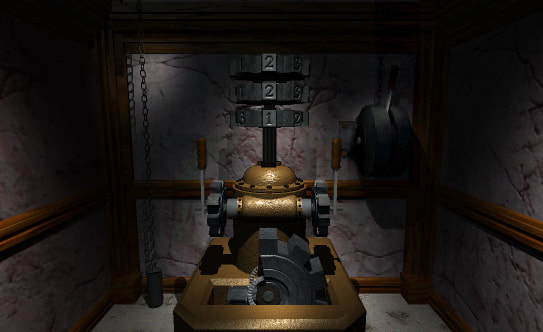Myst - Solving the Gear Puzzle26/1/2018 Over the Christmas break, I finally got around to playing some Computer Games, which I unfortunately haven't done in ages. One really fun game (if you're like me and love difficult puzzles) is a game called Myst. It was originally released in 1993 as a point and click puzzle adventure game, but it has subsequently been remade, using the Unity engine, as a full 3d interactive game. I really liked the fact that there is no time limit, no danger of dying, just a cool story, interesting puzzles and relaxing music. One puzzle that I thought was cool involved aligning gear wheels. If you haven't played the game and don't want spoilers, then stop reading now. The Gear Puzzle We are given the contraption in the image below, and are told that we need to end up with the numbers 2,2,1 (reading from top to bottom). We have three levers we can pull, the left lever moves the top two gears left once, the right lever moves the bottom two gears right once. The lever on the back wall resets the machine. The starting values of the gears are 3,3,3. So how many times do we need to pull each lever in order to end up at 2,2,1? After playing around with it for a while I began to think that it might not even be possible to get to 2,2,1 using the two levers. Then I thought if that's true, can I prove it as well? Proof that the puzzle is impossible Instead of thinking of the value as $3$, let's call it $0$ instead. We can then think of the starting state as a vector:
$$ \begin{bmatrix} 0 \\ 0 \\ 0 \end{bmatrix} $$ And we can think of the left lever as adding on the following vector: $$ \begin{bmatrix} 1 \\ 1 \\ 0 \end{bmatrix} $$ And the right lever as adding the following vector: $$ \begin{bmatrix} 0 \\ 1 \\ 1 \end{bmatrix} $$ We need to work in $mod$ $3$ in order to properly account for the fact that after we go past $3$, we come back to $1$. Then the goal is to produce the state: $$ \begin{bmatrix} 2 \\ 2 \\ 1 \end{bmatrix} $$
To see that we are not able to do this with just the basic operations from the starting point we are given, note that the the sum of the first and third elements of our starting vector is equal to the second vector mod $3$, that is, $0 + 0 \equiv 0$ $(mod$ $3)$. For the vector we trying to create, the first and third is not congruent to the second element mod $3$. Instead we have $ 2 + 1 \equiv 0$ $(mod$ $3) $ rather than $2$.
The two operations we are applying to our starting vector preserve this congruence property, as it applies to both the vectors we are adding on as well. Therefore, we can conclude that this property is an invariant of the system, and because our goal does not satisfy this condition, we will never be able to reach:
$$ \begin{bmatrix} 2 \\ 2 \\ 1 \end{bmatrix} $$
by just using simple pulls of the lever. We need to realise this in order to force us to look for an alternative way to solve the puzzle. Otherwise we would probably just keep yanking on the levers in the hope that we will eventually get there. Once we realise this and start looking around, we are able to find another way to manipulate the machine, allowing us to make the numbers we need. |
AuthorI work as an actuary and underwriter at a global reinsurer in London. Categories
All
Archives
April 2024
|


 RSS Feed
RSS Feed
i love thise game my fav
Leave a Reply.